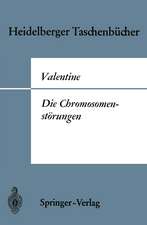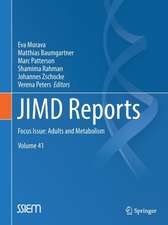Genomic Elements in Health, Disease and Evolution: Junk DNA
Editat de Kyriacos Felekkis, Konstantinos Voskaridesen Limba Engleză Hardback – oct 2015
| Toate formatele și edițiile | Preț | Express |
|---|---|---|
| Paperback (1) | 982.97 lei 38-44 zile | |
| Springer – 22 aug 2016 | 982.97 lei 38-44 zile | |
| Hardback (1) | 1008.07 lei 38-44 zile | |
| Springer – oct 2015 | 1008.07 lei 38-44 zile |
Preț: 1008.07 lei
Preț vechi: 1061.13 lei
-5% Nou
Puncte Express: 1512
Preț estimativ în valută:
192.89€ • 201.41$ • 159.28£
192.89€ • 201.41$ • 159.28£
Carte tipărită la comandă
Livrare economică 11-17 aprilie
Preluare comenzi: 021 569.72.76
Specificații
ISBN-13: 9781493930692
ISBN-10: 1493930699
Pagini: 315
Ilustrații: XI, 315 p. 40 illus., 34 illus. in color.
Dimensiuni: 155 x 235 x 22 mm
Greutate: 0.79 kg
Ediția:1st ed. 2015
Editura: Springer
Colecția Springer
Locul publicării:New York, NY, United States
ISBN-10: 1493930699
Pagini: 315
Ilustrații: XI, 315 p. 40 illus., 34 illus. in color.
Dimensiuni: 155 x 235 x 22 mm
Greutate: 0.79 kg
Ediția:1st ed. 2015
Editura: Springer
Colecția Springer
Locul publicării:New York, NY, United States
Public țintă
ResearchCuprins
Chapter 1 MiRNAs’ Function and Role in Evolution: Under the View of Genomic Enhancement Phenomena
Konstantinos Voskarides and Kyriacos Felekkis
Chapter 2 MicroRNAs in Disease
Gregory Papagregoriou
Chapter 3 piRNAs- Transposon Silencing and Germ Line Development
Catherine Demoliou
Chapter 4 Long Non-Coding RNA
Monika Gullerova
Chapter 5 Unveiling Transposable Elements Function to Enrich Knowledge for Human Physiology and Disease Pathogenesis
Ioannis S. Vizirianakis, Elsa P. Amanatiadou, and Sotirios S. Tezias
Chapter 6 Copy Number Variation in Human Health, Disease and Evolution
Carolina Sismani, Costas Koufaris, and Konstantinos Voskarides
Chapter 7 Mini- And Micro-Satellite Markers in Health, Disease and Evolution
Vasiliki A. Galani, Sofia Markoula, Leandros Lazaros, Paris Ladias, Ioannis Georgiou
Chapter 8 Intron Biology, Focusing on Group II Introns, the Ancestors of Spliceosomal Introns
María Dolores Molina-Sánchez, Rafael Nisa-Martínez, Fernando M. García-Rodriguez, Francisco Martínez-Abarca, Nicolás Toro
Chapter 9 Centromeres in Health, Disease and Evolution
Thian Thian Beh and Paul Kalitsis
Chapter 10 Structure and Functions of Telomeres in Organismal Homeostasis and Disease
Penelope Kroustallaki and Sarantis Gagos
Chapter 11 Proximal Regulatory Elements with Emphasis on CpG Rich Regions
Pavlos Fanis
Chapter 12 Genomic Analysis through High-Throughput Sequencing
Michalis Hadjithomas
Konstantinos Voskarides and Kyriacos Felekkis
Chapter 2 MicroRNAs in Disease
Gregory Papagregoriou
Chapter 3 piRNAs- Transposon Silencing and Germ Line Development
Catherine Demoliou
Chapter 4 Long Non-Coding RNA
Monika Gullerova
Chapter 5 Unveiling Transposable Elements Function to Enrich Knowledge for Human Physiology and Disease Pathogenesis
Ioannis S. Vizirianakis, Elsa P. Amanatiadou, and Sotirios S. Tezias
Chapter 6 Copy Number Variation in Human Health, Disease and Evolution
Carolina Sismani, Costas Koufaris, and Konstantinos Voskarides
Chapter 7 Mini- And Micro-Satellite Markers in Health, Disease and Evolution
Vasiliki A. Galani, Sofia Markoula, Leandros Lazaros, Paris Ladias, Ioannis Georgiou
Chapter 8 Intron Biology, Focusing on Group II Introns, the Ancestors of Spliceosomal Introns
María Dolores Molina-Sánchez, Rafael Nisa-Martínez, Fernando M. García-Rodriguez, Francisco Martínez-Abarca, Nicolás Toro
Chapter 9 Centromeres in Health, Disease and Evolution
Thian Thian Beh and Paul Kalitsis
Chapter 10 Structure and Functions of Telomeres in Organismal Homeostasis and Disease
Penelope Kroustallaki and Sarantis Gagos
Chapter 11 Proximal Regulatory Elements with Emphasis on CpG Rich Regions
Pavlos Fanis
Chapter 12 Genomic Analysis through High-Throughput Sequencing
Michalis Hadjithomas
Recenzii
“This is the first time I have seen a volume on genomics from the island of Cyprus. … The chapters are well written, are of high quality, and the references cited reflect an intimate knowledge of current literature. … This is a useful source for an introduction to the noncoding regions of the human genome.” (Krishna Dronamraju, The Quarterly Review of Biology, Vol. 92 (2), June, 2017)
Textul de pe ultima copertă
This book provides a thorough review of various non-coding genomic elements and discusses in depth their role in health, disease and evolution. It begins with an exploration of non-coding RNA molecules miRNAs, piRNAs, LncRNAs and transposable elements as these moieties dominate the scientific literature the last ten years. The second part of the book discusses copy number variation regions, mini and micro satellites, and proximal and distal elements of the genome. The last section of the book focuses on the review of well-known non-coding regions of the genome, introns, centromeres and telomeres, but enriched with newly discovered functions. As the vast amount of data in regards to these elements is attributed to a great degree to the growing technology in the field of biomedicine, the last chapter of the book discusses the latest development in the field of Next Generation Sequence and the potential applications of this technology in the study of non-coding regions of the genome. This new volume provides an in depth background on ‘junk DNA’ and helps set the stage for future research, and is an essential tool for those in the field.
Caracteristici
Includes information and novel functions about all the known genomic elements in a single publication
Discusses the physiologic function of these elements their role in disease and evolution
This book is dedicated exclusively to non-coding genomic elements
Includes supplementary material: sn.pub/extras
Discusses the physiologic function of these elements their role in disease and evolution
This book is dedicated exclusively to non-coding genomic elements
Includes supplementary material: sn.pub/extras





























